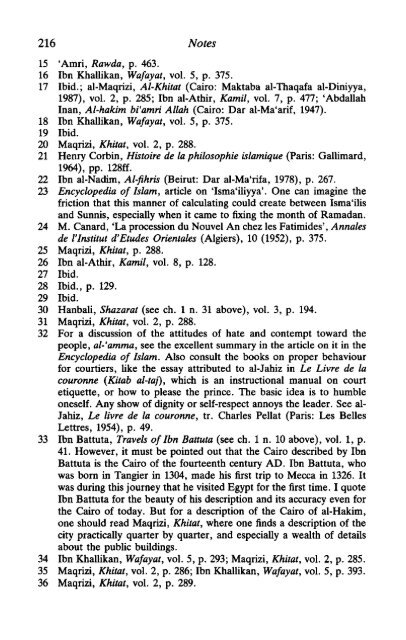Fatima.Mernessi_The-Forgotten-Queens-of-Islam-EN
Fatima.Mernessi_The-Forgotten-Queens-of-Islam-EN
Fatima.Mernessi_The-Forgotten-Queens-of-Islam-EN
Create successful ePaper yourself
Turn your PDF publications into a flip-book with our unique Google optimized e-Paper software.
216 Notes<br />
15 'Amri, Rawda, p. 463.<br />
16 Ibn Khallikan, Wafayat, vol. 5, p. 375.<br />
17 Ibid.; al-Maqrizi, Al-Khitat (Cairo: Maktaba al-Thaqafa al-Diniyya,<br />
1987), vol. 2, p. 285; Ibn al-Athir, Kamil, vol. 7, p. 477; 'Abdallah<br />
Inan, Al-hakim bi'amri Allah (Cairo: Dar al-Ma'arif, 1947).<br />
18 Ibn Khallikan, Wafayat, vol. 5, p. 375.<br />
19 Ibid.<br />
20 Maqrizi, Khitat, vol. 2, p. 288.<br />
21 Henry Corbin, Histoire de la philosophic islamique (Paris: Gallimard,<br />
1964), pp. 128ff.<br />
22 Ibn al-Nadim, Al-fihris (Beirut: Dar al-Ma'rifa, 1978), p. 267.<br />
23 Encyclopedia <strong>of</strong> <strong>Islam</strong>, article on 'Isma'iliyya'. One can imagine the<br />
friction that this manner <strong>of</strong> calculating could create between Isma'ilis<br />
and Sunnis, especially when it came to fixing the month <strong>of</strong> Ramadan.<br />
24 M. Canard, 'La procession du Nouvel An chez les Fatimides', Annales<br />
de I'lnstitut d'Etudes Orientales (Algiers), 10 (1952), p. 375.<br />
25 Maqrizi, Khitat, p. 288.<br />
26 Ibn al-Athir, Kamil, vol. 8, p. 128.<br />
27 Ibid.<br />
28 Ibid., p. 129.<br />
29 Ibid.<br />
30 Hanbali, Shazarat (see ch. 1 n. 31 above), vol. 3, p. 194.<br />
31 Maqrizi, Khitat, vol. 2, p. 288.<br />
32 For a discussion <strong>of</strong> the attitudes <strong>of</strong> hate and contempt toward the<br />
people, al-'amma, see the excellent summary in the article on it in the<br />
Encyclopedia <strong>of</strong> <strong>Islam</strong>. Also consult the books on proper behaviour<br />
for courtiers, like the essay attributed to al-Jahiz in Le Livre de la<br />
couronne (Kitab al-taj), which is an instructional manual on court<br />
etiquette, or how to please the prince. <strong>The</strong> basic idea is to humble<br />
oneself. Any show <strong>of</strong> dignity or self-respect annoys the leader. See al-<br />
Jahiz, Le livre de la couronne, tr. Charles Pellat (Paris: Les Belles<br />
Lettres, 1954), p. 49.<br />
33 Ibn Battuta, Travels <strong>of</strong> Ibn Battuta (see ch. In. 10 above), vol. 1, p.<br />
41. However, it must be pointed out that the Cairo described by Ibn<br />
Battuta is the Cairo <strong>of</strong> the fourteenth century AD. Ibn Battuta, who<br />
was born in Tangier in 1304, made his first trip to Mecca in 1326. It<br />
was during this journey that he visited Egypt for the first time. I quote<br />
Ibn Battuta for the beauty <strong>of</strong> his description and its accuracy even for<br />
the Cairo <strong>of</strong> today. But for a description <strong>of</strong> the Cairo <strong>of</strong> al-Hakim,<br />
one should read Maqrizi, Khitat, where one finds a description <strong>of</strong> the<br />
city practically quarter by quarter, and especially a wealth <strong>of</strong> details<br />
about the public buildings.<br />
34 Ibn Khallikan, Wafayat, vol. 5, p. 293; Maqrizi, Khitat, vol. 2, p. 285.<br />
35 Maqrizi, Khitat, vol. 2, p. 286; Ibn Khallikan, Wafayat, vol. 5, p. 393.<br />
36 Maqrizi, Khitat, vol. 2, p. 289.


